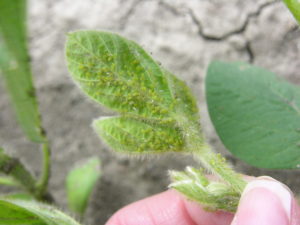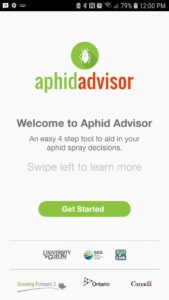
Soybean aphids (SBA) have been reported in a few early planted soybean fields. But that doesn’t mean we need to panic. It has been a few years since we have had major aphid issues so it is good to review what the best management practices are. Especially given one of the main reasons we no longer deal with soybean aphids every year is because natural enemies play a major role in controlling them for us. If we mess that up by spraying too early, we take the natural enemies out, leaving us to have to manage the aphids on our own. Chemical control is never 100% effective, so any surviving aphids repopulate plants within a matter of days. Insecticide trials conducted in multiple states and provinces over several years have shown that insecticide applications in the V stages of soybeans is premature, resulting in no yield response and increases the risk of requiring a second application in the R stages.
It is normal to find aphids colonizing soybean fields in the early V stages, especially in early planted fields or fields close to buckthorn. Soybean aphids initially start to colonize in pockets of early planted fields. Several plants in these pockets can have hundreds, even thousands of aphids on them at first. Walk a few meters away from these pockets and you won’t find any aphids. Once crowded on these plants, the next generation will produce wings to spread out, colonizing new plants in the field or leave that field to enter a new one. This continues to occur, particularly when the plants are still in their V stages. During this time, natural enemies start to notice their presence and will start to feed on these new colonies. It doesn’t matter if fields had insecticide seed treatment or not. Research has shown that the insecticide is only at concentrations that can manage aphids in the first two weeks after planting. After that, they are very similar to fields without seed treatments.
When is the best time to manage soybean aphids? During R1 to R5 stage of soybeans, an insecticide application is required once 80% of the plants in the field have at least 250 aphids per plant and it is apparent that the population is on the increase. This threshold gives an approximate 7–10-day lead time before the aphids would reach the economic injury level (~600 aphids per plant), where cost of control is equal to yield loss. Experience has shown that natural enemies can keep the aphid population fluctuating around the 250 aphid threshold. This fluctuation means they are working hard for you, trying to take down the aphid population. Remember too, aphid reproduction starts to slow down in hot temperatures (~30C) so checking fields more than once is important to see if the natural enemies are keeping up. Only when you see that the aphid populations continue to rise instead of fluctuate, do you know that the natural enemies are not plentiful enough to keep up. Once soybeans reach the R6 stage, more aphids per plant are needed to see a yield response.
What if it is a dry year? Shouldn’t we sprayer sooner? The answer is yes, but not until the field has reached the 250 aphids per plant threshold. Again, there is some buffer between the threshold and the economic injury level. In stressed years when the canopy is shorter and plants are struggling from lack of moisture, then you spray shortly after threshold is reached. In stressed years, aphid populations thrive on potassium deficient plants (it improves nitrogen uptake for the aphids) so important to scout fields with low potassium soils. In a lush healthy crop, you can hold off longer and spray closer to the economic injury levels.

To help you make a spray decision use the free Aphid Advisor app (www.aphidapp.com). Enter the crop stage, level of aphids you are seeing, and the number of different natural enemies present and the app will do the rest. Don’t worry, there are pics in the app to help you figure out the important natural enemies of SBA. The app then takes into consideration the weather forecast for the next 7 days and calculates the aphid reproduction rate at those temps versus the consumption rates of the natural enemies present. It will then tell you if you can hold off spraying, check the field again later or if a spray is required. It helps to take the guess work out of your spray decision.
There are several foliar products registered for soybean aphids and are listed in Publication 812. Make sure to apply in the evening or early morning to avoid the hottest times of the day and to protect pollinators.
Comments are closed.